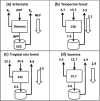Perturbations in the carbon budget of the tropics
- PMID: 24902948
- PMCID: PMC4261894
- DOI: 10.1111/gcb.12600
Perturbations in the carbon budget of the tropics
Abstract
The carbon budget of the tropics has been perturbed as a result of human influences. Here, we attempt to construct a 'bottom-up' analysis of the biological components of the budget as they are affected by human activities. There are major uncertainties in the extent and carbon content of different vegetation types, the rates of land-use change and forest degradation, but recent developments in satellite remote sensing have gone far towards reducing these uncertainties. Stocks of carbon as biomass in tropical forests and woodlands add up to 271 ± 16 Pg with an even greater quantity of carbon as soil organic matter. Carbon loss from deforestation, degradation, harvesting and peat fires is estimated as 2.01 ± 1.1 Pg annum(-1); while carbon gain from forest and woodland growth is 1.85 ± 0.09 Pg annum(-1). We conclude that tropical lands are on average a small carbon source to the atmosphere, a result that is consistent with the 'top-down' result from measurements in the atmosphere. If they were to be conserved, they would be a substantial carbon sink. Release of carbon as carbon dioxide from fossil fuel burning in the tropics is 0.74 Pg annum(-1) or 0.57 MgC person(-1) annum(-1) , much lower than the corresponding figures from developed regions of the world.
Keywords: carbon emissions; deforestation; forest degradation; human development index; land-use change.
© 2014 John Wiley & Sons Ltd.
Figures




References
-
- Achard F, Eva HG, Stigberg H-J, et al. Determination of deforestation rates of the world's humid tropical forests. Science. 2002;297:999–1002. - PubMed
-
- Achten WMJ, Verchot LV. Implications of biodiesel-induced land-use changes for CO2 emissions: case studies in tropical America, Africa, and Southeast Asia. Ecology and Society. 2011;16 doi: 10.5751/ES-04403–160414. - DOI
-
- Alongi DM. Carbon sequestration in mangrove forests. Carbon Management. 2012;3:313–322.
-
- Amundson R. The carbon budget in soils. Annual Review of Earth and Planetary Science. 2001;29:535–562.
Publication types
MeSH terms
Substances
LinkOut - more resources
Full Text Sources
Other Literature Sources

